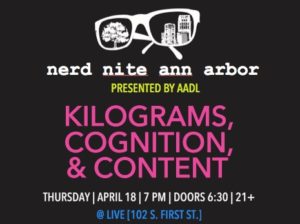 It’s going to hard to MEASURE how much INTELLIGENCE (artificial and otherwise) and DATA are coming together to make April’s NNA2 great!
It’s going to hard to MEASURE how much INTELLIGENCE (artificial and otherwise) and DATA are coming together to make April’s NNA2 great!
We’ll have NSF calibration officer Heather Wade with the tale of the kilogram standard and its recent reconfiguration. U-M Ph.D. candidates Steven Jones and Bryan Stearns will outline the role cognitive architecture plays in artificial intelligence. RELATE alum and Ph.D. candidate Ben Swerdlow will discuss the intersection of Big Data and ethics. This month’s NNA2 will amaze, inform, and entertain, so invite a friend, grab a drink, and find a seat for another excellent NNA2!
When: Thursday, 4/18/19
Doors at 6:30/talks at 7 pm
Where: LIVE, 102 S. First St
Cost: Free! This night out is sponsored by the Ann Arbor District Library!
 Ben Swerdlow – The Medium Place: Big Data and Ethics
Ben Swerdlow – The Medium Place: Big Data and Ethics
We deal with big data every day through social media, advertisements, digital assistants, and more. However, big data is also used in finance, health care, and criminal justice to make choices that impact many, but often behind the scenes. In this talk, I will go over how algorithms learn from data, how this process can unintentionally go wrong, and what ethical questions arise when they do. These questions will not be settled by the end of the talk, but in discussing them I hope we can learn to think more critically about the data-fueled world around us.
About Ben:
Ben is a Ph.D. candidate at the University of Michigan studying materials science and engineering through computer simulations of self-assembling nanoparticles. As part of his studies, he learned about the predictive power of data science as well as the ethical considerations presented at this talk. When not thinking about materials science or big data, you can find him watching YouTube videos, playing board or video games with friends, or cooking.
Steven Jones and Bryan Stearns – The Cogs of Cognition

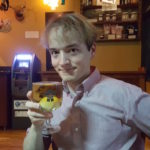 Human thinking can do some amazing things – sometimes! And sometimes our thinking doesn’t work out so well. Either way, thinking seems to happen very fast and seems to use a fixed set of components. How do we do it? Sure, we (humans) do thinking with neurons, but our talk will focus on describing some high-level systems that describe how the brain works, and which we can use to simulate (sometimes intelligent!) human behavior.
Human thinking can do some amazing things – sometimes! And sometimes our thinking doesn’t work out so well. Either way, thinking seems to happen very fast and seems to use a fixed set of components. How do we do it? Sure, we (humans) do thinking with neurons, but our talk will focus on describing some high-level systems that describe how the brain works, and which we can use to simulate (sometimes intelligent!) human behavior.
About Steven and Bryan:
Steven and Bryan are both Ph.D. candidates at the University of Michigan researching cognitive architectures. Bryan studies the computational principles of skill representation and learning. In his spare time, he likes reading, videography, theology, learning new skills, and singing when no one is listening. Steven studies how we record and use long-term memories. He enjoys video games, board games, and dystopic settings.
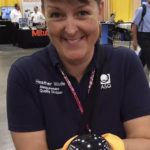 Heather Wade – The Life and Death and Life of the Kilogram
Heather Wade – The Life and Death and Life of the Kilogram
The kilogram was the last remaining human-made physical base measurement artifact and which served as the base measurement of mass. It has been redefined based on unchanging natural physical constants. So, like the second, the meter, the ampere, the Kelvin, the candela, and the mol, it can be created and proven anywhere and the value won’t change. Come and learn about the new kilogram and how it’s defined.
About Heather:
Heather is proud to be a big nerd. She holds a BS in Biology from the University of Michigan. She has worked as a microbiologist, an extraction and analytical chemist, a physical test engineer, and a water treatment specialist before finding her way into the field of metrology. She is currently Calibration Officer at NSF International, in Ann Arbor, MI; an independent, not-for-profit and non-governmental organization committed to protecting public health and safety worldwide. She has experience in chemical, mass, dimensional, time, electrical, pressure, flow, temperature, and luminous intensity calibrations. She is responsible for supporting all of the test equipment, developing and validating calibration methods, ensuring staff competency, and developing uncertainty budgets. Heather holds ASQ-CCT (Certified Calibration Technician) certification and has been a leader and subject matter expert for the ongoing development of the ASQ-CCT exam. She is currently Treasurer and a past Chair of ASQ Measurement Quality Division (MQD). She’s published in several nerdy publications, including in ASQ-MQD’s “The Standard” and in Cal Lab Magazine; The International Journal of Metrology. Heather is one of the co-authors of The Metrology Handbook, 2nd Ed., edited by Jay Bucher. To further her “nerd-cred”, she is also featured in the Cool Careers in Metrology DVD and website. She has presented papers at Measurement Science Conference, NCSL International Conference, the 21st Asia-Pacific Quality Conference, 2014 China Conference on Quality, and the 10th Shanghai International Symposium on Quality. She is an active member of NCSLI’s Testing Lab committee and Test Equipment Asset Management committee and its subcommittee on Delay Dating. She is also a previous speaker at Ann Arbor’s Nerd Nite.
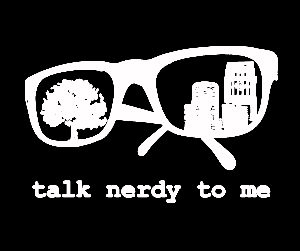
NNA2 is dishing up another informally informative evening and we want YOU to join us! Our menu features specials including mathematics Ph.D. student Jasmine Powell exposing the freakiness of fractals and their never-ending patterns, astronomy Ph.D. student Gillen Brown explaining how stars blew up a million years ago and landed all over our periodic table, and evolutionary biologist and virologist Kayla Peck shares Louis Pasteur’s legacy through crystals, milk, and rabies. Pull up a chair and enjoy!
When: Thursday, 3/21/19
Doors at 6:30/talks at 7 pm
Where: LIVE, 102 S. First St
Cost: Free! This night out is sponsored by the Ann Arbor District Library!
 Gillen Brown – Origin of the Elements
Gillen Brown – Origin of the Elements
Just after the Big Bang, hydrogen and helium were the only elements in the universe. 14 billion years later, we have everything from argon to zinc. The story of how the elements were made includes the beginning of the universe itself, the death throes of stars like our sun, and at least three types of exploding stars. I’ll cover the handful of ways the universe builds elements, then walk through the periodic table to show where each element comes from.
About Gillen:
Gillen is a Ph.D. student in the astronomy department at the University of Michigan, where he studies how elements are distributed within galaxies by using computer simulations. When not writing code, he enjoys watching sports, camping throughout the beautiful state of Michigan, and riding roller coasters.
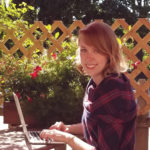 Jasmine Powell – Funky Fractals
Jasmine Powell – Funky Fractals
While the spotlight on math often takes the form of its many direct applications to problems in other fields, there’s another, quieter side of math lurking in the background: understanding and solving problems arising not from any real-world issues, but instead from abstract patterns. Throughout this talk, we’ll delve into my own research on this side of things, and in the process will discover a collection of intricate, beautiful, surprising abstract shapes called fractals. Through talking about what I do and why I love it, I’ll touch on questions about what “pure math research” looks like and why it’s not as intimidating as it sounds.
About Jasmine:
Jasmine is a Ph.D. candidate in mathematics at the University of Michigan and a native Ann Arborite. She loves thinking about math: how to learn it, how to teach it, and how to extract its intrinsic beauty. When she’s not at a local coffee shop working on research, you can find her playing board games, doing an escape room, or embarking on her quest to eat at every restaurant in Ann Arbor.
 Kayla Peck – Crystals, Milk, and Rabies: LP’s legacy
Kayla Peck – Crystals, Milk, and Rabies: LP’s legacy
French scientist Louis Pasteur left his mark on science in a bunch of weird ways. Let’s explore them together!
About Kayla:
Kayla first became an LP fangirl sometime in 2007 during Organic Chemistry I. Coincidentally, her career path also resulted in the study of deadly pathogens. She earned her PhD in Biology in 2016 and is primarily interested in virus evolution and how viruses emerge into humans. When not in lab, she can be found catching pokemon, reading medieval fantasy, playing scrabble, or coming up with new Shrek drinking game rules.
NNA2 wants to know: How sturdy is YOUR skeleton?!!? No idea? Well, chemistry grad student Isabel Colón-Bernal will help clue you in. Assistant professor of Slavic languages and literatures Ania Aizman will be introducing us to anarchy and if you’re wondering where we could possibly be going next, neuroscience grad student Sharena Rice will be our guide through the labyrinth of brain functions that results in navigation. It’s going to be nerdy, it’s going to be night, it’s going to be all the things you ever dreamed Nerd Nite A2 could be! Hope you can join us for another great NNA2.
When: Thursday, 2/21/19
Doors at 6:30/talks at 7 pm
Where: LIVE, 102 S. First St
Cost: $0, I know, what a deal, right?
 Sharena Rice – A Brief History of [Inner] Space: Understanding the Brain’s GPS
Sharena Rice – A Brief History of [Inner] Space: Understanding the Brain’s GPS
Where are we? How do we know it? Where are we going? In this talk, I will discuss how the three-pound organ between our ears helps us find our way from point A to point B.
About Sharena: I am pursuing a Ph.D. in neuroscience and an MS in bioinformatics at the University of Michigan. Deep life conversations enthrall me. I can be found playing the electric saxophone in a Buddhist temple. My project uses virtual reality, robots, and lasers to understand how the brain navigates through space. Yes. I occasionally get lost.

Ania Aizman – Anarchism in Russia and the US
Nowadays anarchists are variously seen punching Nazis, setting police cars on fire, or offering free bike repair and starting community gardens. Is there a coherent set of ideas uniting these things? Is there a history to them? One way to tell the origin story of anarchism is to trace its emergence in Russia, from its successes and failures in the revolutionary movement against Tsarism to its persecution by the Soviet regime. Driven to exile, anarchists from Russia and Eastern Europe came to New York, helping to establish anarchist collectives across the United States.
About Ania: Like many people raised on Russian novels, I was drawn to radical ideas from an early age. But I walked into my first political demonstration by accident, and I practically stumbled on this topic (anarchism in Russia) as an academic, a researcher. There’s work to do to fill in the historical gaps, because no government — Tsarist, Soviet, or any other stripe — likes opposition to the state as such. Censorship and persecution have been with the anarchists from the beginning, but so have their various strategies of survival. Works of art and literature where radical ideas persisted are the focus of my research. I’m a member of the Michigan Society of Fellows and assistant professor of Slavic Languages and Literatures at U of M.
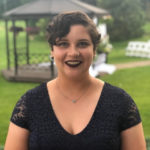
Isabel D. Colón-Bernal – The Chemistry that Backs Our Bones
Osteoporosis is a degenerative bone disease affecting about 75 million people worldwide. Recently, a link between what bones are made of, or composition, and how easily they break, or fracture risk, has been found. In addition, we know that composition is related to fracture risk, yet it has not been studied at the proper scale. In my research, I’m using AFM-IR to look at bone composition at ~50nm. I want to understand how bone composition at the nanoscale can affect a bone’s biomechanical properties at the macro scale. I want to see how bone composition can vary with disease and treatment. Understanding what bones are made of and how this changes their biomechanical properties will improve our understanding of osteoporosis, and how to treat it.
About Isabel: Isabel is a graduate student and scientific communications writing fellow in the Chemistry Department at the University of Michigan. As a member of the Banaszak Holl Lab, her research is on understanding the change in chemical composition of bones and microstructure of collagen as a function of disease and treatment, and how this relates to mechanical properties. She came to Michigan after graduating from her bachelor’s degree in Chemistry from the University of Puerto Rico Rio Piedras campus. Find her @BoriChemist.
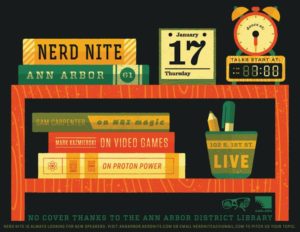 For NNA2 #61, we’ll be diving into MRIs and what we can and cannot learn about the brain with neuroscience researcher Sam Carpenter, exploring how protons are structured, inside and out, with physics grad student Nicole Lewis, and talking about why we play – or don’t play – video games with Mark Kazmierski. So come pick up some facts you didn’t know before and use ‘em to wow your non-Nerd Nite A2 friends! As always, it’s free, courtesy of the Ann Arbor District Library, so grab a friend, grab a drink, and enjoy another informal/informative evening at NNA2!
For NNA2 #61, we’ll be diving into MRIs and what we can and cannot learn about the brain with neuroscience researcher Sam Carpenter, exploring how protons are structured, inside and out, with physics grad student Nicole Lewis, and talking about why we play – or don’t play – video games with Mark Kazmierski. So come pick up some facts you didn’t know before and use ‘em to wow your non-Nerd Nite A2 friends! As always, it’s free, courtesy of the Ann Arbor District Library, so grab a friend, grab a drink, and enjoy another informal/informative evening at NNA2!
When: Thursday, 1/17/2019
Doors at 6:30, talks at 7 pm
Where: LIVE, 102 S. First St.
Cost: Free! Gee, thanks, AADL!
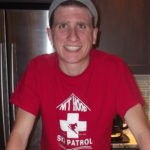 Sam Carpenter – MRI: Magic Really-cool Images
Sam Carpenter – MRI: Magic Really-cool Images
We often hear in the media about some new scientific study where “brain scans reveal something interesting” But often, not a lot of effort goes into describing what is meant by a “brain scan”, how they work and what they can tell us. A common method of “brain scan” is Magnetic Resonance Imaging (MRI). I’ll be breaking down what an MRI is, how they work and what we can and cannot learn about the brain.
About Sam: I am a Pennsylvania native who relocated to Portland, OR in 2010 where I started working in behavioral neuroscience research at Oregon Health & Science University. My technical experience with MRI physics via Penn State set me up to be a part of one of the largest longitudinal neuroimaging adolescent studies at the time. On the job, I learned how to code in a variety of languages, build and run image processing pipelines as well as how to talk ADHD children still for 2+ hrs in the MRI machine. I have scanned over ~1000 individuals ranging in age from 12 days to 88 years. I started in an M.S. program in Bioinformatics at OHSU in 2016 but withdraw in order to move with my spouse to Ann Arbor for a career opportunity. Check me out on Twitter @carpensa1.
 Mark Kazmierski – Game On! Why you do (or don’t) Play Video Games
Mark Kazmierski – Game On! Why you do (or don’t) Play Video Games
What makes games so addictive. In a world of over-stimulation and short attention spans, what makes games the thing that we are drawn to? We will attempt to break down what keeps people playing, as well as what prevents people from getting started.
About Mark: A 29-year-old gamer who has playing since he had the strength to lift a controller, Mark Kazmierski has always had just as much an interest in the culture and development of games as he does playing them. He’s no gaming professional, he’s just a regular guy with enthusiasm about something he loves. Follow him @Kazman2007.
 Nicole Lewis – Unpacking the Proton
Nicole Lewis – Unpacking the Proton
Scientists have known since the 60s that the proton is made of smaller particles called quarks and gluons that are tightly bound together by the strong nuclear force. This process is responsible for 98% percent of the mass of the visible universe. Which would be great if we had any idea how it worked. I study proton-proton collisions that are at a high enough energy that the proton breaks up into a spray of particles. By studying the particles that come out of this spray and how they are arranged in space, we can learn more about the internal structure of the proton
About Nicole: Nicole is a physics PhD student at the University of Michigan studying the structure of the proton and part of the PHENIX collaboration at Brookhaven National Lab. When not thinking about work, she spends most of her time thinking about Harry Potter, Buffy the Vampire Slayer, and Dungeons and Dragons.
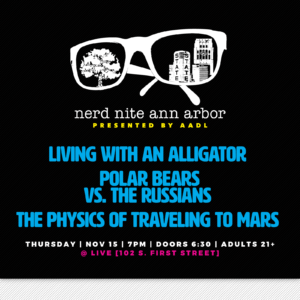
Join us at NNA2 #60 for amazing tales (tails?) from the front lines of animal rescue, battlefields, and plasmadynamics! Staff from the Creature Conservancy will share their mission of animal conservation through education with stories from some of their more unusual permanent residents. Local historian James Mann will take us back to 1918 and the time Michiganders fought the Bolsheviks on their own turf. And then physicist Marcel Georgin shoots his mouth off about the advanced rocket propulsion systems that’ll someday take us to Mars. Kick back with friends, throw back a drink or two, and enjoy Nerd Nite A2!

Gather ‘round, nerd friends, for another amazing entry in our NNA2 adventure! Join us as Manorama Kadwani explains ways bioelectronic therapies could solve medical pee-mergencies (and others), artist and author Hannah Burr discusses her work at the intersection of fine art and science, and music therapist Callie Finzel rhapsodizes about the amazing effects music can have on the brain. It’s going to be fun!!!! It’s going to be interesting!!!!! It’s going to be NERD NITE A2!!!!!!!!! So don’t miss out – bring a friend, grab a drink, and grab a seat!
When: Thursday, 10/18/2018
Doors at 6:30/talks at 7 pm
Where: LIVE, 102 S. First St.
Cost: Free, courtesy of the Ann Arbor District Library
 Manorama Kadwani – Bioelectronic Medicine: talking with nerves
Manorama Kadwani – Bioelectronic Medicine: talking with nerves
People with the problem of frequent need to pee want to get back their bladder control. Patients of such a neurological disorder suffer from not only physical problems, but it affects their work performance, social outings and there’s a stigma about others getting to know about it. Conventional therapies like drug prescriptions have side effects and surgeries do not help many bladder dysfunction patients. So what else can help them? There are prosthetic devices in the market, based on a new therapy called Bioelectronic medicine. My research is focused on understanding the mechanism of this therapy by creating computational simulations of neurons and their interaction with these tiny prosthetic devices. So is this the alternative therapy of future? Can it help patients of other neurological disorders?
About Manorama: I am a Master’s student at the University of Michigan. I am pursuing research under Dr. Tim Bruns, focusing on a type of sensory neurons and their interactions with tiny prosthetic devices with the ultimate aim of designing better prosthetic devices for bladder dysfunction. In my free time, I like to explore what Ann Arbor has to offer for art lovers! I have always loved sketching, but to improve my craft I like to attend the drawing classes in AADL. I am also beginning to learn the Ballroom dancing, because dance makes me happy!
 Hannah Burr – Art Among the Elements
Hannah Burr – Art Among the Elements
Burr will describe the slog and float of creating an artists book about the elements: the essential learnings of her creative process, what she’s extracting from the silos of science, and how much weirder reality is than expected.
About Hannah: Hannah Burr is a Boston MA native who has lived in A2 for just over a year. She’s a contemporary artist and author of two books on the intersection of creative and contemplative practice. Her third book, on the naturally occurring elements of the periodic table, will be out this winter. Burr is a Cum Laude graduate of Brown University and tends to create bridges through her projects to subjects too specialized or fleeting for most people to engage with, including practices sometimes called religious or spiritual, and recently, scientific. Burr’s artwork has been exhibited in the contemporary wing of the Museum of Fine Arts Boston, the Currier Museum in NH, and the Drawing Center in New York NY. Follow her on Twitter @good_bonfire.
 Callie Finzell – Musical Mentality: A Melodious Monologue on Music and the Mind
Callie Finzell – Musical Mentality: A Melodious Monologue on Music and the Mind
Music, like love, is all around. It permeates our everyday lives in both obvious and more obscure ways. This talk will dive into the weird world of musical neuroscience and its applications for therapy. How is music processed in the brain? How can it be used to effect movement, alleviate pain, improve cognition, and facilitate well-being? And what do government-funded LSD research trials have to do with it?
About Callie: Like many who have graced this stage before her, Callie Finzel, MT-BC, has a few letters behind her name and plenty of nerdy interests…that are completely irrelevant to this talk. A graduate of the University of Michigan and Eastern Michigan University, Callie is a music therapist in hospice care who sings and plays piano, guitar, and whatever miscellaneous percussion instruments show up around the house. She is interested in the interaction between music interests and conception of self because, as the Fraggles say, “music makes us real.” When she’s not playing, listening to, or thinking about music, Callie enjoys baking, reading, watching supernatural tv shows with strong female leads, and 100%-ing the Lego Harry Potter video games, with or without the help of her wife and cats.
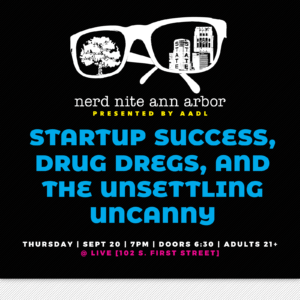
It’s happening again! Nerd Nite A2 is back as entrepreneur Leann Abad guides us through the ecosystem that new businesses need to thrive, pharmaceutical scientist Vernon Lalone reveals the impact of medication accumulation in our bodies, and Kat Johnson creeps us out with an examination of that strange feeling of intimate unfamiliarity – the uncanny. Grab a friend, grab a drink, and a grab a seat for Nerd Nite A2 #58!
When: Thurs. 9/20/2018
Doors at 6:30/talks at 7 pm
Where: LIVE, 102 S. First St.
Cost: Nothing! Sponsored by the Ann Arbor District Library!

Leann Abad – Startup Ecosystems: What Michigan Needs
When you hear the word startup, what do you think about? Do you think tech? Retail? Duo Security? Regardless of what you envision, we know one thing for sure: startups are what drive economic growth and development. This talk goes over what Michigan needs to continue growth as a startup ecosystem.
About Leann – Director of Content, Argonomo; Founder, ASHE Media; Host of the Impact Michigan and Generation [I] podcasts. Passionate about entrepreneurship, digital media, and building the Michigan startup ecosystem. Follow him @leann_abad.
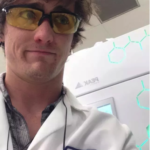 Vernon Lalone – The Search for Drugs Within: A Multi-Scale Journey from Organs to Organelles
Vernon Lalone – The Search for Drugs Within: A Multi-Scale Journey from Organs to Organelles
Did you know that many FDA-approved drugs accumulate inside organs and tissues of our bodies, sometimes so much so that they actually form crystals inside cells? Have you ever wondered where drugs go when we consume them? Throughout this talk, we will explore routes of administration, the fate of drugs inside our bodies (the ways they distribute throughout different organs and cell organelles), and the use of laser-scanning microscopy for the measurement of drug accumulation inside immune cells.
About Vernon: Vernon is a PhD candidate in Pharmaceutical Sciences at the University of Michigan College of Pharmacy. He is part of an interdisciplinary research team of scientists, engineers, and medical professionals studying the effects of long-term drug exposure and adverse drug reactions. Vernon was born and raised in Northern Michigan and has lived throughout this glorious state his entire life. When he’s not peering through a microscope, he spends his time pursuing balance in life through socialization, exercise, spirituality, literature, musical/visual art, and other creative avenues.
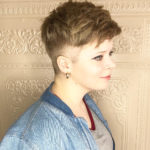 Kat Johnson – It’s Uncanny! Why Do I Feel So Anxious and Upset and What Does It Mean?
Kat Johnson – It’s Uncanny! Why Do I Feel So Anxious and Upset and What Does It Mean?
The Uncanny is nothing and nowhere, the feeling of not being at home in a situation that should be familiar. We’ll delve into this psychological and media theory about what it means to be full of not knowing, not full of knowing, and to enter the Twilight Zone at the edge of science and imagination.
About Kat: Kat is a graduate of the University of Michigan with a degree in Screen Arts in Cultures. She currently does not know what she is doing in any capacity whatsoever, but she really digs media analysis and holding a microphone, so here she is. You can probably find her hosting bar trivia, hosting the Borderline Insanity with Kat and Alex podcast, or reading anything of any sort. Follow her at @whoiskatreally.

This entry in the Nerd Nite Ann Arbor universe is full of stories! Kayla Coughlin has got amazing behind-the-scenes anecdotes and details of how the beloved books of your childhood were written and illustrated. Justin Schell will make your mad scientist dreams come true by explaining how you – YES, YOU – can pitch in on experiments and data collection and maybe, just maybe, make Bill Nye and Neil DeGrasse Tyson proud. And graphic novelists (and husband-and-wife) will share the story of how they wrote Science Comics: Rockets! as a team, and still like each other today. So gather ’round, kids, because it’s story time at NNA2!!!
When: Thursday, August 16 – doors 6:30 pm/talks 7:00 pm
Where: LIVE (102 S 1st St)
No cover charge – Gee, thanks, AADL!
 ABCDWTF: Things You Probably Didn’t Know About Classic Kids’ Books – Kayla Coughlin
ABCDWTF: Things You Probably Didn’t Know About Classic Kids’ Books – Kayla Coughlin
Remember some of those favorite books from your childhood? The ones with potty-mouthed authors, illustrators who couldn’t draw, and characters who cheated on their diet because cake is delicious? Kayla will discuss the largely unacknowledged truths of popular children’s literature.
About Kayla:
Kayla doesn’t talk about herself much in third person and eagerly seeks opportunities to learn something new. She has a background in K-12 education and information science. Her current pursuits include improv, sewing, and maybe eating a vegetable every now and then.
 Stand back, we’re all going to do science! – Justin Schell
Stand back, we’re all going to do science! – Justin Schell
Learn about the many ways you can join people across the world in addressing some of the biggest social and scientific challenges in the world today through community and citizen science apps, websites, hikes, photos, and more!
About Justin:
Justin Schell directs the Shapiro Design Lab at the University of Michigan Library, where he facilitates, among other things, a variety of citizen and community science projects. In addition to this work, he has a background as a documentary filmmaker, community archivist, and reformed trombonist.
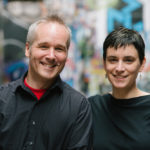 How to Survive Making a Graphic Novel With Your Spouse – Anne and Jerzy Drozd
How to Survive Making a Graphic Novel With Your Spouse – Anne and Jerzy Drozd
Navigating a relationship with your spouse or partner can be challenging enough–so why would you willingly work together on a project that can take a year or more to complete? Anne and Jerzy Drozd, authors of Science Comics: Rockets, explore how they handled the creative challenges of making a nonfiction comic about science and answer the most important question facing humanity today: WHO. DID. WHAT.
About Anne:
Anne Drozd is a public librarian by day and a cartoonist by night. She’s an avid space exploration enthusiast and a card holding member of the Planetary Society. Her favorite NASA mission is Apollo 12. Anne helps to introduce people to comics through her work at the Ann Arbor District Library and as co-organizer of the Ann Arbor Comic Arts Festival. Follow her @ethelfred.
About Jerzy:
Jerzy Drozd is one of the artists of The Warren Commission Report. He leads cartooning workshops for children and teens in libraries and schools, as well as for teachers who want to bring comics to the classroom. He also podcasts about comics and how to make them. Drozd has drawn special projects for Glencoe/McGraw-Hill, Marvel Comics, VIZ Media, and others. Follow him @jerzy.
Here’s a collection of things you have maybe never thought of: an examination of what exactly constitutes a race riot, the secrets of maintaining an all-metal home, and the narrative function of cats in film. Nerd Nite A2 has assembled a brilliant lineup of people who have done the thinking of each of these topics for you – and they’re here to open your eyes. So invite a friend, grab a drink, and prepare to go down a few rabbit holes. See you there!
When: Thursday, July 19 – doors 6:30 pm/talks 7:00 pm
Where: LIVE (102 S 1st St)
No cover charge – AADL is sponsoring!
 American Race Riots — Our National Sport? – Sherlonya Turner
American Race Riots — Our National Sport? – Sherlonya Turner
The United States has been the site of hundreds of race-based disorderly confrontations that can be described as race riots. By now, most everyone has seen images from riots on TV whether it’s a riot from the 1960s, or from the more recent unrest in Ferguson, Missouri or Baltimore, Maryland. But what is a riot? Why do they happen? What are the trends? Common themes? While one can learn quite a bit from the study of any of these individual events, taking on the topic broadly has different lessons for us. This talk will discuss the overall trajectory of race riots in the United States, exploring the greater context for mass race-based conflict.
About Sherlonya: Sherlonya is a department manager at AADL. When she’s not doing that, she can’t stop starting projects. Right now she is into learning about race riots, but is also into history-based baking, open letter writing, and a variety of sewing and crafts. If any of that interests you, you can find most of it at sherlonya.net or follow her on Twitter @sherlonya.
 Lustron: America’s Heavy Metal Housing – John Heider
Lustron: America’s Heavy Metal Housing – John Heider
Lustron homes were factory-made all-metal homes developed after WWII for the booming housing market. Most of their surfaces, inside and out and on their roofs were made of enameled steel. John lives in one, and will be sharing the ins and outs of occupying an all-metal home.
About John: John was a 28 year veteran newspaper photojournalist who was recently retired against his will and is also a ninja school dropout.
 The Film Cat-alogue: A Hiss-tory of Felines in Meow-vies – Jen Proctor
The Film Cat-alogue: A Hiss-tory of Felines in Meow-vies – Jen Proctor
This illustrated lecture will provide an overview of the history of cats in movies, including their character types, their narrative functions, the notion of the “feline gaze,” and, of course, cuteness ratings on a scale from 1 to ZOMG KITTEH!!!
About Jen: Jen is a filmmaker and Associate Professor of Journalism and Screen Studies at UM-Dearborn. In her spare time, Jen studies abnormal feline behavior.
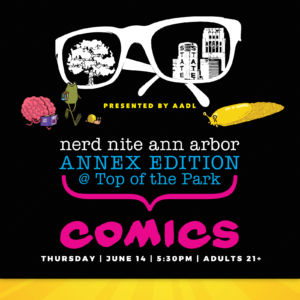
After a hiatus in May, up pop TWO Nerd Nites for June — this first one, at Top of the Park, features some marvelous comix nerds, who are in town for the Ann Arbor Comic Arts Festival (A2CAF). So we (kindly) kidnapped them for a special Nerd Nite!
Zack Giallongo’s going to tell us why scaring kids can be a GOOD thing, Maris is here to fill us in on adventures in Antarctica, and Hanah Stiverson shows us how comics allow readers to dig into new ways to explore what it means to be human.
Please note the earlier time and different locale than a usual Nerd Nite!
When: Thursday, June 14 – doors 5 pm/talks 5:30 pm
Where: The Annex, Top of the Park, Ann Arbor Summer Festival (915 E Washington St, Ann Arbor, MI 48109)
No cover charge – thanks, AADL!
Zack Giallongo — I’ll Give You Something To Be Scared Of!: Why It’s Good To Be Frightening To Children
A look at the storytelling techniques that use frightening and disturbing imagery for kids, and why those stories stick with us through the relatable heroes that overcome them
About Zack:
Zack is a professional cartoonist and teacher, and a not very professional banjo-player or dresser. You might know him from his work on various Star Wars books, including the Ewok graphic novel, Shadows of Endor, and the series of Doodle books. You might also know him from his NYT bestselling graphic novel, Broxo, about teenage barbarians and zombies. He loves animals, D&D, and writing about himself in the third person.
Find him online here: @zackules
Maris Wicks — Is It Cold In Here or Is It Just Me?
Everything you ever wanted to know about Antarctica, and probably some stuff you didn’t (like that time I pooped in a bucket).
About Maris:
Comic book artist and writer with an insatiable appetite for science. Especially science in strange places
Find her online here: @mariswicks
Hanah Stiverson — The Future Is Non-human: Examples of the Comic Book Mutant, Cyborg, and Alien
American comics have historically been used as a way of imagining other modes of being. Since the creation of Superman humanity has been allowed an imagined space of greater power, ability, and capability. In recent years comics have transformed to include a wider range of experiences and bodies, and to allow for fuller beyond-human experience. In this talk I will be looking at examples of recent comic books that imagine fantastical ways of being, which allow readers to explore their humanity from new perspectives.
About Hanah:
Hanah Stiverson is currently a PhD student at the University of Michigan in the department of American Culture. Her current research focuses broadly on comics as a mode through which race, gender, sexuality and power can be articulated. Hanah works primarily with Image Comics texts to consider the ways in which access to a profitable creator-owned market has allowed traditionally marginalized voices new space to create dynamic works. Hanah is the co-coordinator of the Transnational Comics Workshop, which brings together scholars from many fields to encourage an interdisciplinary approach to reading and engaging with comics as a medium.
 It’s going to hard to MEASURE how much INTELLIGENCE (artificial and otherwise) and DATA are coming together to make April’s NNA2 great!
It’s going to hard to MEASURE how much INTELLIGENCE (artificial and otherwise) and DATA are coming together to make April’s NNA2 great! Ben Swerdlow – The Medium Place: Big Data and Ethics
Ben Swerdlow – The Medium Place: Big Data and Ethics
 Human thinking can do some amazing things – sometimes! And sometimes our thinking doesn’t work out so well. Either way, thinking seems to happen very fast and seems to use a fixed set of components. How do we do it? Sure, we (humans) do thinking with neurons, but our talk will focus on describing some high-level systems that describe how the brain works, and which we can use to simulate (sometimes intelligent!) human behavior.
Human thinking can do some amazing things – sometimes! And sometimes our thinking doesn’t work out so well. Either way, thinking seems to happen very fast and seems to use a fixed set of components. How do we do it? Sure, we (humans) do thinking with neurons, but our talk will focus on describing some high-level systems that describe how the brain works, and which we can use to simulate (sometimes intelligent!) human behavior. Heather Wade – The Life and Death and Life of the Kilogram
Heather Wade – The Life and Death and Life of the Kilogram


























